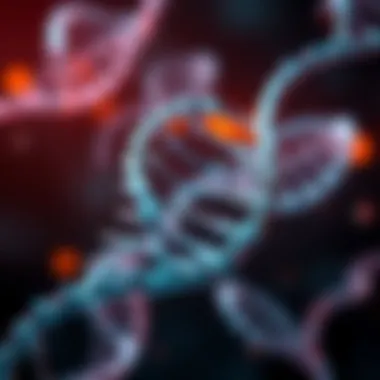Understanding DNA Testing for Paternity Confirmation


Intro
DNA testing has evolved from a complex scientific procedure into a crucial tool for many personal and societal issues. One of its most significant applications is in determining paternity. With the rise of such tests, the landscape of familial relationships has shifted dramatically, revealing not just biological truths, but also emotional complexities and legal ramifications.
In today's society, the notion of 'family' extends beyond mere blood ties, and understanding one's lineage can significantly impact identity and personal relationships. Paternity testing is not just a matter of curiosity; it can carry heavy implications in matters like child support, inheritance, and psychological well-being for all parties involved.
Through this article, we will explore the ins and outs of DNA testing, particularly its role in paternity confirmation. We’ll unpack the underlying science, the methodologies employed, and the emotional weight these tests can carry for individuals. Understanding these elements is crucial, not just for determining biological relationships, but also for grasping the implications they have on familial and societal structures.
Methodology
To thoroughly comprehend the role of DNA testing in paternity confirmation, it's essential to dive into the methodologies used in these tests. The science behind DNA analysis is intricate yet fascinating, as it relies on the understanding that every person has a unique genetic blueprint, which they inherit from their parents.
Study Design
The study design for evaluating DNA testing methodologies typically includes a mix of qualitative and quantitative approaches. These may involve analyzing case studies where DNA tests were utilized to resolve paternity disputes. Researchers might also conduct interviews with professionals in genetics, law, and psychology to gather insights on how these tests affect families. A comprehensive review of existing literature on the accuracy and reliability of various testing methods adds significant context.
Data Collection Techniques
Data collection usually involves skin or saliva samples, as these are two of the most common sources of DNA. Following collection, the samples are processed in a lab. Polymerase Chain Reaction (PCR) is often used to amplify the DNA, allowing detailed analysis without requiring large amounts of biological material. Additionally, genealogical databases can be utilized to compare genetic markers across populations, which further enhances the understanding of paternity connections.
Discussion
In the following sections, we will analyze the results derived from these methodologies. By interpreting the data collected, insights can be drawn regarding the effectiveness and reliability of paternity tests.
Interpretation of Results
The results of DNA paternity tests are typically expressed in terms of probability. A result may indicate, for example, a 99.9% likelihood that an individual is the biological father. This mathematical certainty, however, does not always equate to emotional acceptance. There are cases where results reveal unexpected truths, leading to complex psychological and relational issues.
Limitations of the Study
While DNA testing provides significant clarity in paternity issues, it's not without its issues. One limitation stems from the potential for misinterpretation of results. Emotional bias can cloud judgment, and sometimes people may struggle to accept the outcomes, regardless of scientific backing. Also, the technology's advances can lead to inconsistent results across different testing labs, raising concerns about quality control.
Future Research Directions
As the science of genetics evolves, ongoing research is crucial for improving paternity testing methodologies. Future studies could focus on enhancing accuracy, understanding the emotional responses to testing, and developing comprehensive guidelines for individuals seeking paternity tests.
"Understanding genetic ties is like unraveling the threads of fate that connect us to one another."
For further reading, you can explore resources like Wikipedia, or Britannica.
Prologue to DNA Testing
DNA testing is a scientific process that has dramatically transformed our understanding of genetics and family relationships, particularly in the area of paternity verification. It offers a concrete method to ascertain biological connections, which can be pivotal in various contexts. The ability to confirm or deny familial relationships through genetic analysis is significant not just for personal clarity but also in legal, social, and emotional frameworks that many individuals navigate.
One of the most compelling reasons to explore DNA testing is its accuracy. Modern testing can provide a probability of paternity exceeding 99.9%, a statistic that is hard to argue with. The benefits of this accuracy extend far beyond familial ties; they often impact social welfare, inheritance issues, and even eligibility for birthright citizenship. Individuals involved in custody disputes or family court cases often rely on the results of these tests to assert legal claims.
While delving into the world of DNA testing, it’s important to consider the ethical implications and emotional ramifications it can entail. Such decisions can evoke a firestorm of feelings—joy, anxiety, or even betrayal—especially in cases of disputed parentage. Understanding the depth of DNA testing does not only involve knowledge of scientific principles; it requires sensitivity to the lives affected by such revelations.
In short, this section aims to lay the foundation for a more comprehensive examination of DNA testing. By looking at its definition, purpose, and historical background, we prepare the ground for deeper discussions about the mechanics of paternity testing and its repercussions. The significance of thoroughly understanding DNA testing, especially as it pertains to familial relationships, cannot be overstated.
Scientific Foundation of DNA
The examination of DNA underpins our entire understanding of genetic identity, particularly in the realm of paternity testing. The scientific foundation of DNA forms the bedrock on which methodologies for confirming familial ties are built. This becomes especially important, considering the emotional and social stakes involved in paternity confirmation.
Structure of DNA


To grasp the intricacies of DNA testing, one must first comprehend the structure of DNA. Think of DNA as a twisted ladder, where the sides are made of sugar and phosphate, and the rungs consist of specific sequences of bases: adenine, thymine, cytosine, and guanine. These bases pair in a specific manner; adenine always pairs with thymine, while cytosine pairs with guanine. This unique arrangement contains the blueprint for all living organisms.
One important aspect of DNA is its double helix formation, which not only provides stability but also facilitates replication. When cells divide, DNA unravels, allowing for the creation of new strands. This characteristic is what enables genetic information to be passed down through generations.
Exploring the structure of DNA is vital because it reveals how traits are inherited and how familial relationships can be traced scientifically. When assessing paternity, the examination of specific markers within the DNA structure becomes essential to confirm biological connections.
Genetic Variability and Markers
Now, let’s delve into the concept of genetic variability and markers. Every individual possesses a unique DNA profile, created from the combination of genetic material from both parents. This is where the idea of markers comes into play. Genetic markers are specific sequences within an individual’s DNA that can vary widely among different people. These markers are key in paternity testing, providing vital information to distinguish one individual's DNA from another's.
An effective paternity test often analyzes short tandem repeats (STRs), which are repeating sequences of DNA that are highly variable among the population. The greater the number of markers examined, the higher the accuracy of the paternity test. Generally, tests evaluate 15 to 25 markers, and matching these with the alleged father’s DNA can confirm whether he is, indeed, the biological parent.
Genetic variability is crucial because it enhances the resolution of paternity tests. It not only helps to confirm relationships but also plays a role in revealing the rich tapestry of linked genetic traits, providing insight into ancestry and lineage.
"DNA testing has transformed our understanding of familial connections, illuminating not only paternity but also the complex interplay of heredity."
Paternity Testing Explained
Paternity testing plays a crucial role in understanding familial relationships and establishing legal rights. It not only affects individuals but can also have far-reaching implications for families and communities. The process of confirming parentage can help resolve disputes, assist in matters of inheritance, and affect custody arrangements. Moreover, having clarity and certainty regarding a child's father is significant for both emotional well-being and identity formation.
Types of Paternity Tests
Laboratory Tests
Laboratory tests for paternity are the gold standard in confirming biological relationships. These tests analyze DNA samples from the child, mother, and alleged father, comparing specific genetic markers. One key characteristic of laboratory tests is their high accuracy rate, often exceeding 99.9%. This level of precision makes them a preferred choice among legal and medical professionals.
The main advantage is the comprehensive analysis that can detect even minute differences in genetic makeup. However, the process typically requires a visit to a clinic, which can be a barrier for some. The turnaround time is generally longer too, taking a week or more for results.
At-Home Testing Kits
At-home testing kits provide a convenient alternative for those wishing to confirm paternity without the hassle of lab visits. They generally come with a simple user guide, allowing individuals to collect samples (usually saliva or cheek swabs) from all parties involved. One of the appealing traits of these kits is that they offer privacy and discretion in the testing process.
However, the accuracy can vary significantly between different brands, typically ranging from 85% to 99%. Another aspect to consider is that most at-home tests are not legally admissible in court unless a laboratory, complying with strict chain-of-custody guidelines, conducts the analysis. This can lead to misunderstandings if individuals are not aware of the limitations.
Testing Procedures
Sample Collection Techniques
Sample collection techniques are a vital aspect of any paternity testing process. A clean and proper sample is essential to ensure reliable test results. In laboratory settings, trained professionals often oversee this procedure, using swabs to collect saliva or blood. It's critical that samples are handled according to strict protocols to prevent contamination.
This controlled environment adds reliability, which is invaluable in legal contexts, where results can have significant implications. Conversely, in at-home situations, users may not be as meticulous, leading to potential errors. This factor underscores the importance of educating individuals on the process to maximize accuracy.
Laboratory Analysis Process
Once samples are collected, the laboratory analysis process begins. This involves several stages, including DNA extraction, amplification, and comparison. A distinctive feature of this process is the Polymerase Chain Reaction (PCR), which allows labs to make millions of copies of specific DNA segments. This makes it possible to analyze even the tiniest samples.
The analysis typically includes comparing hundreds of genetic markers, providing a detailed view of biological relationships. However, it requires advanced equipment and expertise, which can increase costs and time. Despite these drawbacks, the reliability of results gained through this meticulous process is invaluable, particularly in legal disputes.
Important Note: Always verify the accreditations of any laboratory conducting DNA testing, as this ensures adherence to industry standards and accuracy of results.
Accuracy and Reliability of DNA Testing
The importance of accuracy and reliability in DNA testing cannot be overstated, particularly in scenarios of paternity confirmation. When individuals seek to determine biological relationships, they rely on results that significantly influence personal, emotional, and legal outcomes. Therefore, understanding the intricacies involved in both the testing process and the resultant data is paramount.
In any paternity test, the foundation lies in the precision with which DNA is analyzed. The typical accuracy rate of these tests is reported at 99.9% when conducted correctly. This high rate underscores that, barring unforeseen errors, the conclusions drawn from these tests hold considerable weight. However, interpreting these results goes beyond mere numerical accuracy. Emotional and societal implications add layers to the understanding of what a positive or negative result means.
"DNA testing does not just confirm biological ties; it can shatter illusions or create new realities for families."


Understanding Test Results and Statistics
Test results in DNA analysis are often expressed in percentages or confidence intervals. When a test indicates a high probability of paternity, it signifies that the genetic markers examined align strongly between the alleged father and the child. The statistical aspect can be intricate as it often involves understanding how many markers were tested and the population's baseline variation.
- Probability of Paternity: This reflects how likely it is that the tested male is the biological father. For instance, a probability of 99.99% suggests almost certainty.
- Exclusion Probability: Should the alleged father lack key markers found in the child, he can be excluded decisively as a parent. This exclusion probability helps clarify biological relationships and can one hundred percent rule out a man's paternity.
A keen understanding of these statistics can provide assurance to families navigating the uncertain waters of paternity and parenthood.
Factors Affecting Test Accuracy
Several factors can influence the accuracy of DNA testing. While the science behind DNA is robust, practical elements may muddy the waters.
- Sample Quality: If the DNA samples collected are contaminated or degraded, it could lead to erroneous results. This often occurs with improper handling or storage of samples before analysis.
- Testing Methodology: The techniques and technologies utilized in testing also play a role. Advanced methodologies have improved accuracy, while older methods may not provide the same reliability.
- Laboratory Standards: Different laboratories may adhere to various regulations and practices. Thus, selecting accredited and well-regarded testing centers is crucial to ensuring reliable outcomes.
- Population Genetics: Variability in genetic markers can also affect results. For instance, certain genetic traits may be more or less common in different ethnic groups, which can skew interpretations of the data in relation to broader populations.
Legal Implications of Paternity Testing
Paternity testing crosses the boundary of science into the realm of law, demonstrating significant legal implications that must be considered. It's a powerful tool in family law, influencing custody battles, child support obligations, and inheritance rights. Understanding these legal facets is crucial, as they can have profound effects on the lives of individuals and families.
Use in Family Court Cases
Paternity tests play a pivotal role in family court teetings. When disputes arise over a child's parentage, the courts often rely on DNA testing to establish legal paternity. This process can lead to several outcomes, including:
- Custody Decisions: Courts must make decisions about whom the child will live with, and knowing the biological father can be crucial.
- Financial Responsibilities: Establishing paternity can affect child support orders. The recognized father may be required to provide financial support, which is vital for the child's well-being.
- Visitation Rights: Once paternity is established, the father can seek visitation rights. This can help build a relationship between the child and father, which has long-term benefits.
The legal ramifications do not just stop there. Establishing paternity also helps clear up any confusion regarding inheritance issues, and can relieve some of the emotional burden carried by families dealing with uncertainty. Since children have the right to a relationship with both parents, effective use of paternity testing in family court promotes the child's best interests.
Privacy Considerations
The introduction of DNA testing into legal settings raises serious concerns surrounding privacy. Once genetic material is submitted for testing, there are questions about where this sensitive information goes and who has access to it. Several key considerations include:
- Data Protection: Genetic data must be stored securely to prevent it from falling into the wrong hands. Courts need to ensure that DNA results are not misused or disclosed without consent.
- Informed Consent: Individuals must give permission for their DNA to be tested, particularly in legal situations. This emphasizes the need for clarity before initiating a test, making sure parties understand what they are consenting to.
- Potential Misuse: With the increasing prevalence of DNA databases, the risk of misuse of genetic information is a serious concern. If paternity testing information is shared or sold without consent, it can lead to gender discrimination, stigmatization, or even genetic discrimination in workplaces and insurance.
Paternity testing is a double-edged sword. While it can provide clarity in familial relationships, the potential legal and ethical mishaps associated with privacy must not be overlooked. Balancing these interests is critical in enforcing laws that address the ramifications of paternity testing.
Emotional and Social Considerations
Understanding the emotional and social considerations surrounding DNA testing, especially in the context of paternity confirmation, is crucial. This aspect dives deeper than the scientific end of things; it penetrates the human experience and the complex web of relationships that DNA testing invariably influences. The stakes are often extraordinarily high, as the test results can reshape familial ties and social dynamics, leading to a spectrum of responses ranging from relief and joy to confusion and despair.
Impact of Testing on Families
The impact of DNA testing on families can be immense. When the truth about parentage is revealed, it can feel like opening Pandora’s box. In some cases, the confirmation of paternity can solidify a father-child bond, paving the way for a nurturing relationship. Many families have shared positive stories where tests allowed previously estranged individuals to reconcile and build a new life together.
On the other hand, there are times when the results may shake the very foundations of family structures. Consider a situation where a father receives shocking results that contradict his belief. This unexpected twist can lead to feelings of betrayal and loss. Family dynamics can be altered, as children may grapple with a newly revealed identity or question their place in the family. Partners might experience doubt or resentment, complicating relationships further.
Ultimately, how families process these results is intricate. Sometimes it's just about picking up the pieces and focusing on the future while feeling the emotional weight of the past. As families navigate through these turbulence, support systems, whether they be professional, social, or familial, play a pivotal role in making sense of it all.
Coping with Results
Coping with the results of a paternity test is rarely straightforward. Individuals may go through a veritable rollercoaster of emotions. At first, shock might set in, followed by a whirlwind of questions and concerns. Queries such as, "What does this mean for my relationship with my child?" or "How will my family react?" swirl through the mind.
To ease the burden, talking openly with a trusted confidant or a mental health professional can be invaluable. Emotional support is essential. Engaging in support groups, either physically or online—perhaps on platforms like Reddit or dedicated Facebook groups—can also provide a sense of community. It's beneficial to know that you're not alone in this journey, and others have faced similar situations.
During this time, focusing on self-care becomes critical. It can involve anything from simple daily routines to seeking hobbies or engaging in mindfulness practices. Moreover, approaching the future with an adaptable mindset can help; understanding that life can change unexpectedly may allow the individual to pivot and adapt more smoothly.
In summary, the emotional clout of DNA testing is significant. While it can lead to healing and stronger ties, it can also fracture relations and stir up upheaval. Ultimately, recognizing the feelings involved and learning how to cope effectively forms the bedrock of navigating this complex terrain.
Ethical Concerns Surrounding DNA Testing


The evolution of DNA testing, particularly in paternity confirmation, brings a range of ethical concerns that deserve attention. As society evolves, so does the way we perceive genetic information, and navigating the moral landscape of this powerful tool is crucial. The implications of DNA testing extend far beyond scientific curiosity; they touch on fundamental principles of consent, autonomy, and the potential danger of misuse of genetic information. Understanding these concerns is not only essential for families considering paternity testing but also for society at large, as it shapes ethical guidelines and policies surrounding genetic testing.
Consent and Autonomy
Consent is the bedrock of ethical medical practices, and when it comes to DNA testing, it holds even more weight. Individuals have the inherent right to make informed choices about their bodies and personal data. The crux here is informed consent, which means that the person undergoing testing fully understands what the procedure entails, including potential outcomes and implications.
The dilemma arises when the testing involves minors or dependent individuals. Parents often make decisions on behalf of their children, sometimes without their explicit consent. This raises questions about autonomy and the rights of individuals to assert their own preferences regarding participation in genetic testing. One might ponder,
"Is it justifiable for a parent to impose a paternity test on an unwilling child?"
Furthermore, individuals may find themselves in emotionally charged situations. They could be coerced into taking a test by partners or family members who may have ulterior motives. Thus, maintaining clear, ethical boundaries is essential for preventing exploitation and ensuring that participants are genuinely willing.
Potential for Misuse of Genetic Information
As beneficial as DNA testing can be, there’s a darker side lurking beneath the surface—the potential for misuse of the genetic information obtained. Genetic data, once harvested, can be manipulated or misused in ways that individuals may not foresee. Imagine the scenario where one parent has access to a child’s DNA information, but that information could potentially be used against the other parent in custody disputes or even personal vendettas. It poses a threat to privacy and the fundamental trust in familial relationships.
Moreover, there are concerns about the broader implications for society. With advancements in technology, genetic data can be shared or accessed beyond the origin point, raising alarms concerning the integrity of DNA databases. There’s a fine line between using genetic information for medical advancements and opening the floodgates for genetic discrimination.
Consider the ramifications if employers start seeking genetic data to determine health risks before hiring. Such use violates principles of equity and justice, potentially leading to a society where individuals are judged by their genes rather than their capabilities.
For more on this subject, you might find resources like National Human Genome Research Institute useful, as they delve into the intersection of ethics and genetic testing.
Future of DNA and Paternity Testing
The landscape of DNA testing is rapidly evolving, especially in the realm of paternity testing. This evolution is crucial for various reasons. It makes the testing more accessible, reliable, and comprehensive, thus ensuring greater confidence in results. As society becomes increasingly aware of the importance of genetic information, the role of DNA analysis in confirming familial relationships will likely become even more significant. This section delves into the latest advancements in technology and how these changes will impact society at large.
Technological Advancements
Technological progress in DNA testing is marchng forward akin to a high-speed train. Innovations are reshaping how healthcare professionals, legal systems, and families approach paternity testing. One significant advancement lies in next-generation sequencing (NGS), which allows for a detailed analysis of the entire genome rather than limited parts.
- Increased Accuracy: NGS provides a comprehensive overview of a person’s genetic material, resulting in more accurate paternity results. Traditional methods, like short tandem repeat (STR) analysis, while effective, do not offer the same level of detail.
- Speedier Results: The processing time for DNA tests is steadily decreasing due to improved automation and more efficient laboratory techniques. Now, families can obtain results faster, which is critical for both emotional well-being and legal matters.
- Cost Reduction: As technologies advance, the costs associated with DNA testing are also declining. This shift makes testing more accessible not just for the affluent but for a broader demographic, enhancing social equity.
However, it's not merely the technology that’s advancing. The methodologies surrounding DNA testing have undergone a renaissance. Collecting samples has become less invasive, which, in turn, increases participants' willingness to engage with the testing process. For example, saliva tests now rival blood tests in their reliability and ease of collection.
Broader Implications for Society
The implications of advancements in DNA testing extend far beyond individual families. They touch on legal, ethical, and social aspects that could reshape societal perceptions of kinship and identity.
- Legal Frameworks: With advancements in accuracy, paternity testing may play a more pronounced role in legal disputes involving child custody and support. Courts might increasingly rely on such scientifically backed evidence, impacting traditional legal practices.
- Ethical Considerations: As paternity testing becomes common, issues surrounding the right to know will garner attention. Questions about how far individuals can or should go to uncover genetic information may arise. Furthermore, younger generations might face different societal pressures concerning their lineage.
- Education and Awareness: With accessibility comes responsibility. Society must educate individuals about genetic data's implications, ensuring they are aware of privacy considerations and the meaning of their results.
It is evident that as DNA technology improves, it creates ripples across legal, social, and ethical waters, requiring careful navigation.
In sum, the future of DNA and paternity testing beckons promising advancements that not only enhance the scientific approach but also compel society to rethink the significance of genetic connections. The delicate interplay between technology and human relationships will likely demand dialogue among various stakeholders, paving the way for both benefits and challenges in understanding familial bonds.
Epilogue
In this exploration of DNA testing and its integral role in paternity confirmation, the significance of understanding both the science and the emotional ramifications of these tests cannot be overstated. DNA testing, being a concrete method to ascertain biological relationships, assists individuals and families in navigating complex familial ties. Furthermore, it provides a robust framework for legal matters, particularly in family courts. While the information generated can be a source of great relief or clarity, it can also trigger deep emotional responses, depending on the outcome.
Summary of Key Points
- Precision and Accuracy: The reliability of DNA testing methodologies, including both laboratory and at-home tests, ensures that results are highly accurate. This is essential for establishing paternity definitively.
- Legal Relevance: DNA tests are frequently employed in court settings, underpinning child support cases and custody decisions. Their validity in legal contexts underscores their importance.
- Emotional Impact: The potential for results to affect relationships is profound. Beyond the science lies the reality of human connections, and understanding this is crucial for all involved.
- Ethical Considerations: As DNA technology evolves, attention to ethical concerns surrounding consent and privacy becomes increasingly significant. Misuse of genetic data raises necessary questions about autonomy and personal rights.
Call for Continued Research and Awareness
Looking ahead, it’s vital that both researchers and policymakers prioritize ongoing studies into DNA testing technologies. As advancements unfold, being aware of how these changes can affect societal norms is crucial. Key areas for exploration include:
- The effects of wide accessibility of at-home testing on familial relationships and trust.
- Addressing ethical implications around consent, especially concerning minors.
- Continued evaluation of how paternity testing fits into broader conversations about genetic information and privacy in our increasingly interconnected digital lives.
The call to action for increased awareness cannot be ignored; as more individuals seek out DNA testing for personal reasons, public understanding must keep pace with technological advancements. Sharing information and discussing the ramifications openly can foster a more educated society that approaches these sensitive topics with care and maturity.
"Knowledge is power, and in navigating the complexities of personal relationships, understanding the fundamentals of DNA testing is crucial for informed decision-making."
By remaining vigilant and proactive, society can harness the benefits of DNA testing effectively while safeguarding personal rights and emotional well-being.







